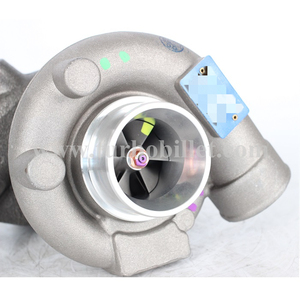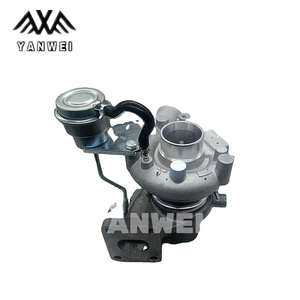(432 products available)





















































































































































































The 4D34 turbo refers to a specific engine model code used by some manufacturers, particularly in reference to diesel engines. The 4D34 engine is a 4-cylinder, in-line engine configuration. It's important to note that specific turbocharger options may vary based on the exact configuration of the engine and its application. Here are some common types of turbochargers that might be associated with the 4D34 engine:
It's essential to refer to the specific engine technical documentation or consult with a turbo specialist to get precise information about the types of turbochargers compatible with a given 4D34 engine configuration.
Here are the specifications of the 4D34 turbo:
Maintenance of the 4D34 turbo engine is crucial to ensure optimal performance and durability. Here are some maintenance tips:
Selecting a turbocharger for 4D34 engines can be a complex process, as there are many factors that need to be taken into consideration. Here are some of them:
Understand the engine
This is the first and most important step. Users need to understand the engine specifications thoroughly. What is the maximum power output? What is the maximum torque? What is the displacement volume? All of these parameters are important to choose a suitable turbo.
Determine turbo size
When choosing a turbocharger, always consider the engine's power goals and the characteristics of the engine. For standard power or slightly increased power, a small turbo is sufficient. However, for high power output, a larger turbo is a must.
Consider turbo type
There are various turbo types available on the market, such as twin-scroll turbos, variable geometry turbos, and electric turbos. Each type has its own advantages and is suitable for different applications. For 4D34 engines, conventional small VGTs are often the most cost-effective choice.
Evaluate turbo specifications
Key specifications of a turbocharger include turbine and compressor wheel sizes, A/R ratio, and boost pressure. These specs have a direct impact on the turbo’s performance and suitability for the engine. For instance, a turbo with a larger compressor wheel can provide more airflow, making it suitable for high power applications.
Check compatibility
Make sure that the turbo is compatible with the 4D34 engine. Factors like the exhaust manifold, oiling system and intake/exhaust piping should all be taken into account. It's crucial that these components are compatible with the turbo to avoid any issues during installation and operation.
Brand and quality
Opt for reputable brands and quality products. A well-known brand usually offers better performance, reliability, and after-sales service. Furthermore, quality products can reduce the risk of turbo failure and engine damage, saving users a lot of money and trouble.
Budget
Determine a budget for the turbocharger and related components. Keep in mind that a higher initial cost may be associated with better performance and reliability in the long run. Don't forget to consider the costs of installation, tuning, and maintenance when evaluating the overall expense.
Replacing a turbo for 4D34 engines can be a complex task, but it can be done with the right tools and mechanical knowledge. Here is a step-by-step guide on how to replace a turbo for 4D34 engines:
Tools and materials needed:
Step-by-step guide
Q1: What does the 4D34 turbo engine power?
A1: The 4D34 turbo engine is a modified version of the 4D34 engine. Mitsubishi originally designed the 4D34 engine for medium-duty trucks and commercial vehicles. It's an in-line four-cylinder engine with a bore measuring 87 mm and a stroke of 102 mm. The 4D34T engine is a turbocharged version of the 4D34 engine. The addition of a turbocharger improves the engine's performance by increasing the power output and torque.
Because of the added turbocharger, the 4D34T engine can generate more power and handle heavier loads compared to the 4D34 engine without a turbocharger. As a result, the 4D34T engine is commonly used in trucks and other commercial vehicles that require a reliable and efficient powertrain.
Q2: What is the 4D34 turbo engine used for?
A2: The 4D34 turbo engine is commonly used in trucks and other commercial vehicles that require a reliable and efficient powertrain. Some examples include delivery trucks, freight trucks, garbage trucks, and logging trucks. The engine's design makes it suitable for off-road vehicles, providing good performance on unpaved roads and rough terrain.
Q3: Can the 4D34 turbo engine be used in smaller vehicles?
A3: While the 4D34 turbo engine is primarily designed for medium-duty trucks and commercial vehicles, it can be used in smaller vehicles if the vehicle's design accommodates the engine's size and weight. Additionally, the engine's performance characteristics may not be ideal for smaller passenger vehicles, as it is tuned for efficiency and power delivery in larger vehicles.
Q4: Is the 4D34 turbo engine suitable for off-road driving?
A4: Yes, the 4D34 turbo engine is designed to provide good performance in off-road conditions. Its turbocharged engine offers sufficient power and torque to handle challenging terrains, such as unpaved roads, gravel, and dirt trails. The engine's performance can be advantageous for off-road vehicles, ensuring reliability and efficiency in various driving conditions.
Q5: How does the 4D34 turbo engine compare to other engine options in its class?
A5: The 4D34 turbo engine is a competitive option within its class of medium-duty diesel engines. Its turbocharged design provides a good balance of power, torque, and fuel efficiency, making it suitable for various applications, such as trucks, commercial vehicles, and off-road vehicles. Other engine options in its class may offer similar performance characteristics, but the 4D34 turbo engine's reliability and durability are often highlighted as key advantages.